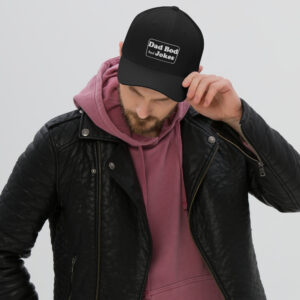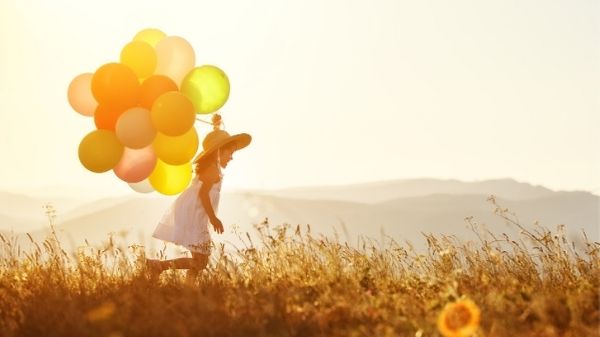Fear rears its ugly head in extraordinary ways.
It is sensible to channel anxiety through dangers such as fire or being too near the edge of a significant drop.
Children need a healthy level of anxiety to protect themselves from harm; in this case, it can be useful.
What occurs within a child’s mind when an object or situation poses no actual harm yet still provokes the same level of anxiety is an example of how fears can grow and potentially force behavioral changes within them.
Kids often evolve or change their fears as they age, especially if they are highly sensitive.
As a toddler, it may be about certain shadows on the wall (causing sleep regression issues or hysterics at bedtime), but as an older child, these anxieties will likely give way to burglars or even death.
But how might they display these fears?
This post will give you some ways that fear manifests itself in kids and 5 actionable tips to help remove fear from a child’s mind.
-

Bold Male Pride – Baseball Trucker Cap Celebrating Masculinity
£18.00 Select options This product has multiple variants. The options may be chosen on the product page -

Dad Bod Appreciation Gift Mug
£14.00 Add to cart -

Dad Bod, Bad Jokes Structured Baseball Cap
£22.00 Select options This product has multiple variants. The options may be chosen on the product page

5 Ways Your Child May Present Fear

As you and I both know, all children are different. Their little quirks and responses make them the individual little souls they are, so they can react in numerous ways when displaying their fears.
Often it doesn’t take long to spot the signs that your little one is anxious about something. Pinpointing it can be challenging, especially as children cannot always put their thoughts into words in the way you or I can.
Let’s take a look and learn some examples of knowing your child is afraid.
Not Sleeping Properly
A classic example of sensing something is amiss in your child’s life is that their nighttime routine is shaken.
This doesn’t necessarily have to be one thing or another, but if you notice the longer it takes to fall asleep at night or hear them toss and turn before they fall asleep, they may have negative thoughts blocking their journey to sleep.
Signs to watch out for include bad dreams or night terrors. Interruptions to a solid sleep signal heavy thoughts on their minds that they are struggling to process in the day.
These often rise to the surface during our slumber as the brain tries to file them away correctly, resulting in busy dreams.
A Change In Behavior
Being scared can frequently lead to confusing times for children who are still trying to figure out emotions and how they work.
If your child is afraid of something, they can exhibit that confused feeling by exerting anger.
They may test the boundaries or get worked up easily over small things.
Our brain process everything all the time, but if fear crops up, those processes get distorted, and emotions aren’t as easily regulated.
It is good to bear in mind the next time you try to create calm around their behavior changes.
Gut Issues
What goes on upstairs can affect downstairs more than you think. There are several links to how our brain and gut work together, and during times of stress or anxiety, you may notice changes in your toilet habits.
For children, it is no different.
Whether they are constipated and frustrated with the lack of movement or the opposite, and they cannot seem to stop using the bathroom, these changes are for a reason.
You may want to sit and talk things through with your child to help them understand what is happening.
Growth In Negative Thoughts
‘I can’t do it’ or ‘I’m not going upstairs by myself’ are classic phrases your child may develop as they come to terms with their worries.
As they get more aware of their feeling toward this one scary thing or situation in their minds, they will find avenues to exude that negativity into other aspects of life.
The best way to illuminate these thoughts is to challenge them. For instance, my son once said to me:
‘Daddy what if I go to my swimming lesson and Sean isn’t there?’
And I replied with:
‘What if Sean is there and you jump in the water and splash him. Would that be funny?’
He laughed, and ten minutes later, some very positive and whacky ‘What if” were coming from both of us!
Positivity is power.
Becoming Clingy
They want to share your bed because they want to feel safe. They want to cuddle you if something is bothering them that you don’t yet know about.
They are scared and come and find you in the middle of the night.
You might lay there at 2:30 am and think, ‘I could do without this,’ but what if you let them come to you and feel that safety?
What a great help to be there if your child needs to talk or offload some of their anxiety.
While it is never advisable to make a fuss if they are fine, it’s always nice to acknowledge their need for a hug.
5 Ways To Remove Fear From Your Child’s Mind

There isn’t a magic wand you can wave that will do this. It takes work and consistency to help your child notice and regulate the fear enough to manage it.
We all need an element of fear and anxiety in our lives to anticipate what lies ahead if the need suffices naturally.
What works for one might not as much for the other.
Want to know how to remove fear from a child’s mind? Here is a list of 5 great methods.
Don’t Belittle Their Fear.
Start by not being a tease. It doesn’t matter if the fear is ridiculous to you; it isn’t to your child; otherwise, they wouldn’t react the way they do.
Small steps to let them see that you understand them are essential in their journey of understanding fear as a concept and acceptance.
Don’t Avoid The Fear.
If your child doesn’t like something to the point where they respond adversely to it, a good idea is not to erase that thing from your life.
You can’t walk around with all the lights on, nor avoid a dog or cat when out.
In tiny and manageable steps, facing what sends you into a panic helps desensitize the issue.
You will be thankful in the long run for these small exposures, and so will your little one.
Educate Your Child
What could be normal for you or me yet sends your child into overdrive can become less daunting if you begin your lessons by educating them.
Dogs may seem scary if you are three years old as they run around the park, but in reality, the dogs are happy and playing with their ball without giving your child a thought.
It is imperative, however, to ensure your child knows not to pet a strange dog.
Forming a new perspective is a method of CBT that is extremely useful in diminishing phobias. Sometimes, it works effectively to ensure your child is aware and informed logically about what consumes them.
Don’t pretend You Are Fearless.
If you want to help your child, make them feel better by showing them your fears. You don’t have to freak out or scream, and equally, your fear could be as small or insignificant to them as theirs are to yours.
Remember, fears are subjective.
Offer a little snippet into your life, and let your child know what happens when you feel anxious or scared.
Sharing this way can calm a child and their worlds as you allow your imperfections to rise to the surface.
Validate Your Child
Make your child feel normal. Kids need to know they are in safe hands and are being listened to. Whatever their worry, if they are coming to you, they are looking for you to help them fix it.
Much can be solved by talking and letting them voice their concerns.
If you allow this without judgment or criticism, your kids will be far more likely to approach you in the future with bigger and more prominent worries as they learn more about their feelings.
That is, after all, what parents are for!
Conclusion – Shift The Focus!
Although it can be hard to iron out all fears, and it is unlikely that anybody walking this planet has zero, an excellent place to start is to change how you perceive these threats.
Helping your child to form a different perspective would benefit them greatly.
A fantastic place to begin, and a best seller is available on Amazon now. ‘CBT Workbook for Kids’ focuses on a CBT approach and has been useful for many parents worldwide.
Good luck!





